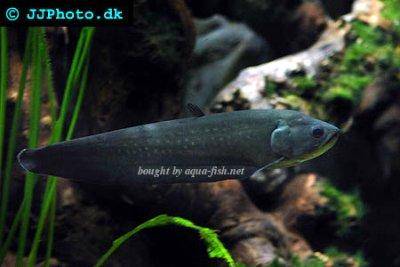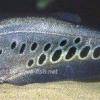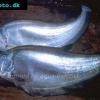Reticulate knifefish - Papyrocranus afer
Scientific name: Papyrocranus afer
Common name: Reticulate knifefish
Family: Notopteridae
Usual size in fish tanks: 70 - 80 cm (27.56 - 31.5 inch)
014
Recommended pH range: 5.5 - 6.5
Recommended water hardness: 4 - 12°N (71.43 - 214.29ppm)
0°C 32°F30°C 86°F
Recommended temperature range: 24 - 30 °C (75.2 - 86°F)
The way how these fish reproduce: Spawning
Where the species comes from: Africa
Temperament to its own species: aggressive/territorial
Temperament toward other fish species: aggressive/territorial
Usual place in the tank: Bottom levels
Short description
The Reticulate knifefish (Papyrocranus afer) is a large, nocturnal African knifefish from slow, turbid rivers and floodplains of West and Central Africa. With an adult size of 70–80 cm, it is best suited to public aquaria or very large, species-focused systems. Shy by day and predatory by night, it requires dim lighting, broad open lanes for cruising, and secure lids (excellent jumper/escape artist).
Origin
Africa — widespread across western/central drainages, including the Niger basin and numerous coastal river systems with slow flow, submerged wood, marginal vegetation, and soft, acidic water.
Food and feeding
A strict carnivore. Offer substantial meaty foods such as prawns/shrimp, fish fillet, mussel, earthworms, and quality carnivore strips. Most specimens can be trained to take thawed frozen foods using tongs; start feeding at dusk when they are most confident. Avoid feeder fish (disease/parasites and poor nutrition). Feed moderate portions 3–5× weekly to prevent water fouling.
Sexing
No reliable external differences reported; mature females may appear fuller. Sexing usually requires behavioral or internal examination.
Breeding
No confirmed home-aquarium breedings. As with other large notopterids, reproduction likely involves seasonal cues (water level/temperature changes) and expansive space. Captive spawning, if it occurs, is usually at public aquaria or research facilities.
Lifespan
Typically 10–15 years with excellent water quality and appropriate diet.
Behavior & compatibility
P. afer is territorial and predatory, especially toward conspecifics and smaller tankmates that can be swallowed. Best kept alone or with large, robust, non-nippy fish that occupy different zones and are too big to be considered prey. Avoid aggressive fin-nippers and fast, boisterous species that will stress or outcompete it at feeding.
Tank requirements
- Tank size: very large footprint; realistically 800–1,500 L (210–400 gal) for a single adult with long swimming runs.
- Scape: open water lanes plus secure tubes/caves (PVC/ceramic logs) and submerged wood for daytime retreat; smooth décor to protect skin.
- Water: soft, slightly acidic (pH 5.5–6.5), temperature 24–30 °C; low to moderate flow with high oxygenation.
- Filtration: oversized bio-mechanical filtration; low nitrate via regular, substantial water changes.
- Lighting: dim; dusk/dawn schedule or floating plants to reduce stress and encourage natural foraging.
- Cover: tight-fitting lid; block gaps around cables/pipes—knifefish are adept escapees.
Care notes
Acclimate slowly and offer food on tongs near the chosen shelter at lights-down. Maintain excellent hygiene—this species is sensitive to poor water quality and sudden parameter swings. Handle with care; the long, delicate body is prone to net damage (use large, soft slings or tubs rather than mesh nets).
⚠️ Care Considerations for Reticulate Knifefish
- Tank size: At least 600 liters (160 gallons); public aquariums or very large private tanks are best.
- Diet: Strictly carnivorous; prefers live or frozen prey (fish, shrimp, worms). Will refuse flakes or pellets.
- Behavior: Highly territorial and often aggressive toward tankmates; best housed singly or with very robust, similar-sized species.
- Lighting: Dim to moderate; species is naturally nocturnal and more active at night.
- Filtration: Requires powerful filtration and high oxygen levels; produces significant waste due to size.
- Special note: Albino forms exist in the hobby but require identical care.
⚠️ This species can grow up to 80 cm and is unsuitable for standard home aquaria. It is best reserved for very experienced keepers or public displays.
Pictures
Bought by aqua-fish.net from jjphoto.dk.




 Clown
Clown  Giant
Giant